Comprehensive Report: Australian Unemployment Levels and Trends
VerifiedAdded on 2020/03/16
|15
|3826
|35
Report
AI Summary
This report provides an in-depth analysis of unemployment in Australia, examining trends from 2013 to 2017, the impact of the Global Financial Crisis, and the current state of the labor market. It defines unemployment, outlines the trends in the Australian labor market, and discusses the disproportionate impact on youth unemployment. The report explores the demand-side and supply-side theories of unemployment, highlighting the factors contributing to the high rates of youth unemployment. It differentiates between these theories and delves into the types of unemployment experienced in Australia, including structural unemployment. The report also considers the factors that cause rampant youth unemployment. The report concludes by emphasizing the need for a balanced approach that addresses both demand- and supply-side factors to effectively combat unemployment and promote economic stability.

Australian Unemployment 1
AUSTRALIAN UNEMPLOYMENT LEVEL
By (Student’s Name)
Professor’s Name
College
Course
Date
AUSTRALIAN UNEMPLOYMENT LEVEL
By (Student’s Name)
Professor’s Name
College
Course
Date
Paraphrase This Document
Need a fresh take? Get an instant paraphrase of this document with our AI Paraphraser

Australian Unemployment 2
AUSTRALIAN UNEMPLOYMENT
Introduction
Australia economy has fallen a victim of unemployment like any other economy in the in
international market. The unemployment rate in the Australia has been changing with no
constant/ pre-determined % of concern. High unemployment rate situation is still being
witnessed in the country in the past five years with 2017’s seasonally adjusted figure being 5.6%
in August 2017 as in the months earlier matching the estimates in the market. During this period,
Australian unemployment rate stood at eleven percent. Such a record rate was subsequent to
worst financial crisis never witnessed in Australia (Evans, 2015).
Australia has had about 6.7 percent unemployment rate on average in the last five years.
The decrease denoted an improvement alongside creation of hope amongst Australians. The
Australia dollar regained its value, economic sectors showed improvement while investors were
enticed to invest in Australia. In 2013, Australia showed the economic performance relative to its
trade partners including the US.
Unemployment Definition
Unemployment exists in a country in case there is any worker who is ready as willing to
work with required and relevant skills and knowledge. Any worker who is willing as well as
ready to work yet is presently not working is regarded as being (Bonoli, 2017). Accordingly,
unemployed individual is one in labor force endowed with the below listed characteristics;
• Lacking any paying job presently and remains actively searching for the job either via
an application letter, online application or walking from a station to another searching for work
• He is willing as well as able to begin working as early as a week ago.
AUSTRALIAN UNEMPLOYMENT
Introduction
Australia economy has fallen a victim of unemployment like any other economy in the in
international market. The unemployment rate in the Australia has been changing with no
constant/ pre-determined % of concern. High unemployment rate situation is still being
witnessed in the country in the past five years with 2017’s seasonally adjusted figure being 5.6%
in August 2017 as in the months earlier matching the estimates in the market. During this period,
Australian unemployment rate stood at eleven percent. Such a record rate was subsequent to
worst financial crisis never witnessed in Australia (Evans, 2015).
Australia has had about 6.7 percent unemployment rate on average in the last five years.
The decrease denoted an improvement alongside creation of hope amongst Australians. The
Australia dollar regained its value, economic sectors showed improvement while investors were
enticed to invest in Australia. In 2013, Australia showed the economic performance relative to its
trade partners including the US.
Unemployment Definition
Unemployment exists in a country in case there is any worker who is ready as willing to
work with required and relevant skills and knowledge. Any worker who is willing as well as
ready to work yet is presently not working is regarded as being (Bonoli, 2017). Accordingly,
unemployed individual is one in labor force endowed with the below listed characteristics;
• Lacking any paying job presently and remains actively searching for the job either via
an application letter, online application or walking from a station to another searching for work
• He is willing as well as able to begin working as early as a week ago.
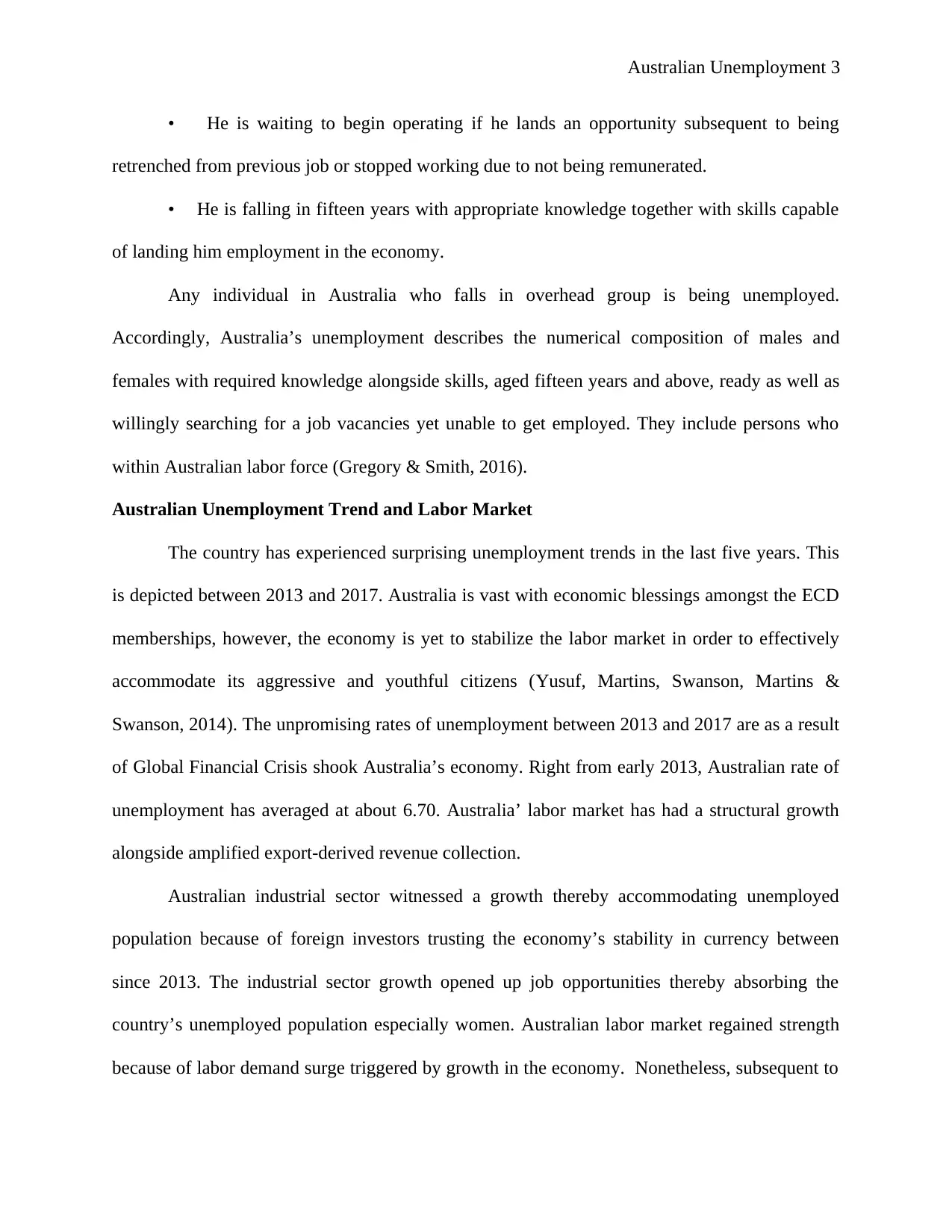
Australian Unemployment 3
• He is waiting to begin operating if he lands an opportunity subsequent to being
retrenched from previous job or stopped working due to not being remunerated.
• He is falling in fifteen years with appropriate knowledge together with skills capable
of landing him employment in the economy.
Any individual in Australia who falls in overhead group is being unemployed.
Accordingly, Australia’s unemployment describes the numerical composition of males and
females with required knowledge alongside skills, aged fifteen years and above, ready as well as
willingly searching for a job vacancies yet unable to get employed. They include persons who
within Australian labor force (Gregory & Smith, 2016).
Australian Unemployment Trend and Labor Market
The country has experienced surprising unemployment trends in the last five years. This
is depicted between 2013 and 2017. Australia is vast with economic blessings amongst the ECD
memberships, however, the economy is yet to stabilize the labor market in order to effectively
accommodate its aggressive and youthful citizens (Yusuf, Martins, Swanson, Martins &
Swanson, 2014). The unpromising rates of unemployment between 2013 and 2017 are as a result
of Global Financial Crisis shook Australia’s economy. Right from early 2013, Australian rate of
unemployment has averaged at about 6.70. Australia’ labor market has had a structural growth
alongside amplified export-derived revenue collection.
Australian industrial sector witnessed a growth thereby accommodating unemployed
population because of foreign investors trusting the economy’s stability in currency between
since 2013. The industrial sector growth opened up job opportunities thereby absorbing the
country’s unemployed population especially women. Australian labor market regained strength
because of labor demand surge triggered by growth in the economy. Nonetheless, subsequent to
• He is waiting to begin operating if he lands an opportunity subsequent to being
retrenched from previous job or stopped working due to not being remunerated.
• He is falling in fifteen years with appropriate knowledge together with skills capable
of landing him employment in the economy.
Any individual in Australia who falls in overhead group is being unemployed.
Accordingly, Australia’s unemployment describes the numerical composition of males and
females with required knowledge alongside skills, aged fifteen years and above, ready as well as
willingly searching for a job vacancies yet unable to get employed. They include persons who
within Australian labor force (Gregory & Smith, 2016).
Australian Unemployment Trend and Labor Market
The country has experienced surprising unemployment trends in the last five years. This
is depicted between 2013 and 2017. Australia is vast with economic blessings amongst the ECD
memberships, however, the economy is yet to stabilize the labor market in order to effectively
accommodate its aggressive and youthful citizens (Yusuf, Martins, Swanson, Martins &
Swanson, 2014). The unpromising rates of unemployment between 2013 and 2017 are as a result
of Global Financial Crisis shook Australia’s economy. Right from early 2013, Australian rate of
unemployment has averaged at about 6.70. Australia’ labor market has had a structural growth
alongside amplified export-derived revenue collection.
Australian industrial sector witnessed a growth thereby accommodating unemployed
population because of foreign investors trusting the economy’s stability in currency between
since 2013. The industrial sector growth opened up job opportunities thereby absorbing the
country’s unemployed population especially women. Australian labor market regained strength
because of labor demand surge triggered by growth in the economy. Nonetheless, subsequent to
⊘ This is a preview!⊘
Do you want full access?
Subscribe today to unlock all pages.

Trusted by 1+ million students worldwide

Australian Unemployment 4
GFC and corresponding effects to all ECD, the labor market of Australian is still weakened to
date. Rate of unemployment has been soaring from 2013 and continued reaching 6.2 percent in
2015 but has since dropped to 5.60% in August 2017.
The country has been caught up in a recessions accompanied with negative impacts on
growth of economy as aftermath. These recessions have accounted for the instability in labor
market in Australia to date. Such recessions including the GFC still account for the damages to
labor expectations in Australia especially the youthful group even between 2013 and 2017.
GFC was accompanied by declined employment period, diminishing opportunities for
job, augmented unemployment periods, decreased opportunities for employment alongside worst
increase in uncertainties over vacancies. The labor market was extremely weakened
characterized by laying offs and retrenchment as the sole option for few working group
accommodation. The Australia has been picking up from 2013 through 2017 with reports
showing 5.6 percent as unemployment rate in August, 2017. Improvement are expected because
of Australia dollar stability alongside economic growth sustainability among ECDO
memberships.
The Australia has unbalanced labor market with respect to distribution of unemployment.
More of the youths are unemployed than adults. About 12 percent of Australian youths remained
unemployed subsequent to the disparaging GFC. Almost 2/3 of Australian total unemployed
persons are youths. Such a trend is discriminatory as it kills the Australian future labor market. A
great percentage of Australian youths aged between fifteen and twenty-four years are not only
ready but also willing to work for the prevailing wage rate but they are unable land any
opportunity (Flèche & Layard, 2017). The Australian high number of unemployed youths is due
to adjustment in structural alongside economic.
GFC and corresponding effects to all ECD, the labor market of Australian is still weakened to
date. Rate of unemployment has been soaring from 2013 and continued reaching 6.2 percent in
2015 but has since dropped to 5.60% in August 2017.
The country has been caught up in a recessions accompanied with negative impacts on
growth of economy as aftermath. These recessions have accounted for the instability in labor
market in Australia to date. Such recessions including the GFC still account for the damages to
labor expectations in Australia especially the youthful group even between 2013 and 2017.
GFC was accompanied by declined employment period, diminishing opportunities for
job, augmented unemployment periods, decreased opportunities for employment alongside worst
increase in uncertainties over vacancies. The labor market was extremely weakened
characterized by laying offs and retrenchment as the sole option for few working group
accommodation. The Australia has been picking up from 2013 through 2017 with reports
showing 5.6 percent as unemployment rate in August, 2017. Improvement are expected because
of Australia dollar stability alongside economic growth sustainability among ECDO
memberships.
The Australia has unbalanced labor market with respect to distribution of unemployment.
More of the youths are unemployed than adults. About 12 percent of Australian youths remained
unemployed subsequent to the disparaging GFC. Almost 2/3 of Australian total unemployed
persons are youths. Such a trend is discriminatory as it kills the Australian future labor market. A
great percentage of Australian youths aged between fifteen and twenty-four years are not only
ready but also willing to work for the prevailing wage rate but they are unable land any
opportunity (Flèche & Layard, 2017). The Australian high number of unemployed youths is due
to adjustment in structural alongside economic.
Paraphrase This Document
Need a fresh take? Get an instant paraphrase of this document with our AI Paraphraser
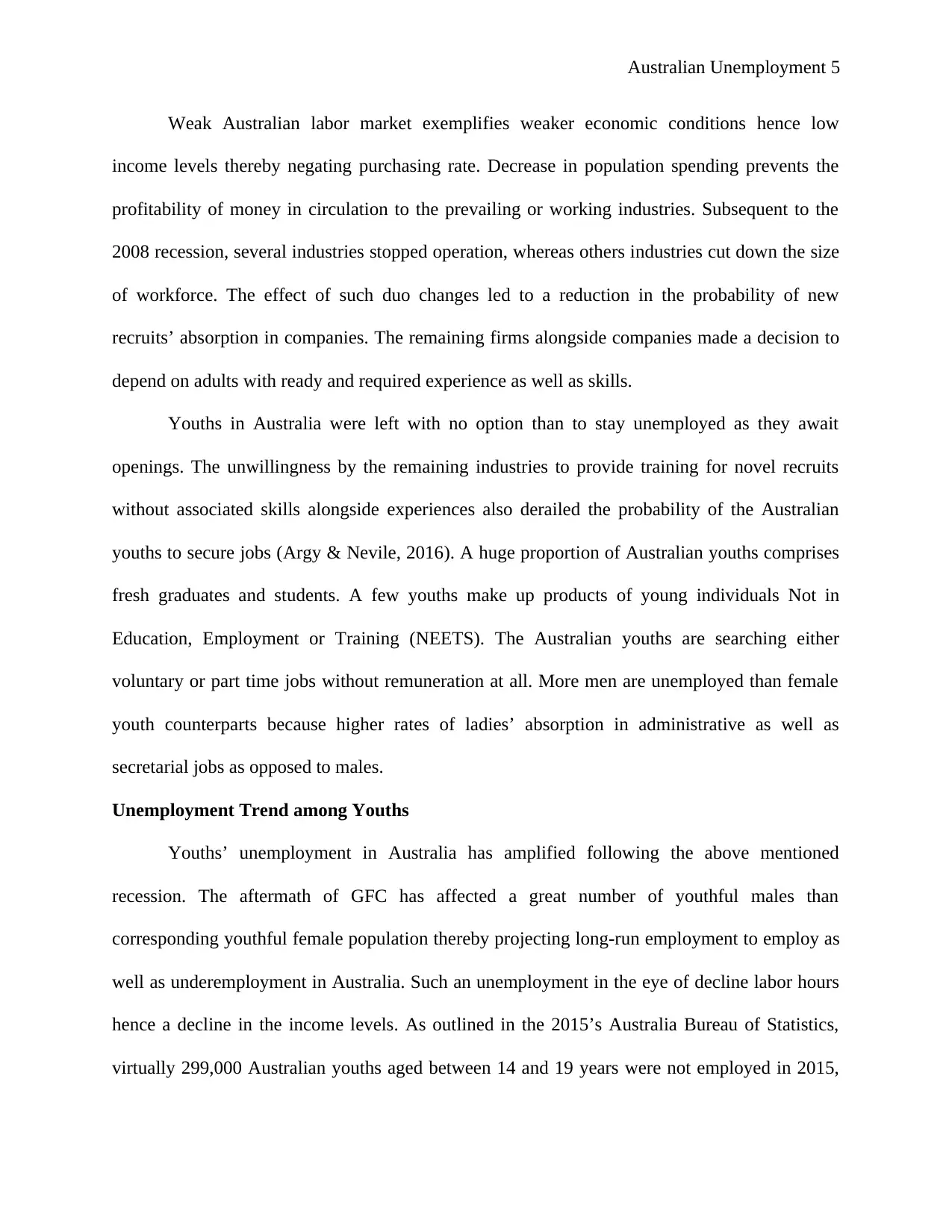
Australian Unemployment 5
Weak Australian labor market exemplifies weaker economic conditions hence low
income levels thereby negating purchasing rate. Decrease in population spending prevents the
profitability of money in circulation to the prevailing or working industries. Subsequent to the
2008 recession, several industries stopped operation, whereas others industries cut down the size
of workforce. The effect of such duo changes led to a reduction in the probability of new
recruits’ absorption in companies. The remaining firms alongside companies made a decision to
depend on adults with ready and required experience as well as skills.
Youths in Australia were left with no option than to stay unemployed as they await
openings. The unwillingness by the remaining industries to provide training for novel recruits
without associated skills alongside experiences also derailed the probability of the Australian
youths to secure jobs (Argy & Nevile, 2016). A huge proportion of Australian youths comprises
fresh graduates and students. A few youths make up products of young individuals Not in
Education, Employment or Training (NEETS). The Australian youths are searching either
voluntary or part time jobs without remuneration at all. More men are unemployed than female
youth counterparts because higher rates of ladies’ absorption in administrative as well as
secretarial jobs as opposed to males.
Unemployment Trend among Youths
Youths’ unemployment in Australia has amplified following the above mentioned
recession. The aftermath of GFC has affected a great number of youthful males than
corresponding youthful female population thereby projecting long-run employment to employ as
well as underemployment in Australia. Such an unemployment in the eye of decline labor hours
hence a decline in the income levels. As outlined in the 2015’s Australia Bureau of Statistics,
virtually 299,000 Australian youths aged between 14 and 19 years were not employed in 2015,
Weak Australian labor market exemplifies weaker economic conditions hence low
income levels thereby negating purchasing rate. Decrease in population spending prevents the
profitability of money in circulation to the prevailing or working industries. Subsequent to the
2008 recession, several industries stopped operation, whereas others industries cut down the size
of workforce. The effect of such duo changes led to a reduction in the probability of new
recruits’ absorption in companies. The remaining firms alongside companies made a decision to
depend on adults with ready and required experience as well as skills.
Youths in Australia were left with no option than to stay unemployed as they await
openings. The unwillingness by the remaining industries to provide training for novel recruits
without associated skills alongside experiences also derailed the probability of the Australian
youths to secure jobs (Argy & Nevile, 2016). A huge proportion of Australian youths comprises
fresh graduates and students. A few youths make up products of young individuals Not in
Education, Employment or Training (NEETS). The Australian youths are searching either
voluntary or part time jobs without remuneration at all. More men are unemployed than female
youth counterparts because higher rates of ladies’ absorption in administrative as well as
secretarial jobs as opposed to males.
Unemployment Trend among Youths
Youths’ unemployment in Australia has amplified following the above mentioned
recession. The aftermath of GFC has affected a great number of youthful males than
corresponding youthful female population thereby projecting long-run employment to employ as
well as underemployment in Australia. Such an unemployment in the eye of decline labor hours
hence a decline in the income levels. As outlined in the 2015’s Australia Bureau of Statistics,
virtually 299,000 Australian youths aged between 14 and 19 years were not employed in 2015,
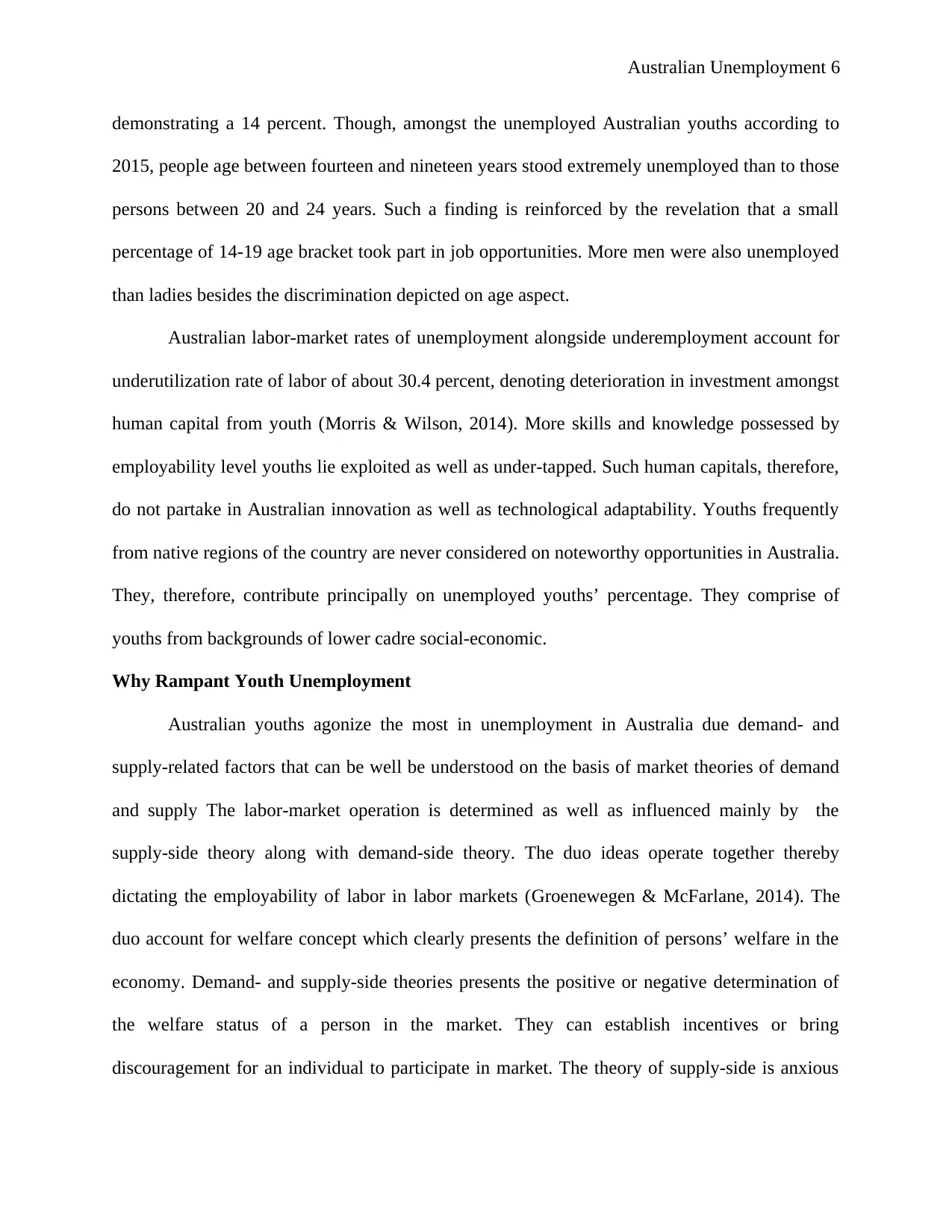
Australian Unemployment 6
demonstrating a 14 percent. Though, amongst the unemployed Australian youths according to
2015, people age between fourteen and nineteen years stood extremely unemployed than to those
persons between 20 and 24 years. Such a finding is reinforced by the revelation that a small
percentage of 14-19 age bracket took part in job opportunities. More men were also unemployed
than ladies besides the discrimination depicted on age aspect.
Australian labor-market rates of unemployment alongside underemployment account for
underutilization rate of labor of about 30.4 percent, denoting deterioration in investment amongst
human capital from youth (Morris & Wilson, 2014). More skills and knowledge possessed by
employability level youths lie exploited as well as under-tapped. Such human capitals, therefore,
do not partake in Australian innovation as well as technological adaptability. Youths frequently
from native regions of the country are never considered on noteworthy opportunities in Australia.
They, therefore, contribute principally on unemployed youths’ percentage. They comprise of
youths from backgrounds of lower cadre social-economic.
Why Rampant Youth Unemployment
Australian youths agonize the most in unemployment in Australia due demand- and
supply-related factors that can be well be understood on the basis of market theories of demand
and supply The labor-market operation is determined as well as influenced mainly by the
supply-side theory along with demand-side theory. The duo ideas operate together thereby
dictating the employability of labor in labor markets (Groenewegen & McFarlane, 2014). The
duo account for welfare concept which clearly presents the definition of persons’ welfare in the
economy. Demand- and supply-side theories presents the positive or negative determination of
the welfare status of a person in the market. They can establish incentives or bring
discouragement for an individual to participate in market. The theory of supply-side is anxious
demonstrating a 14 percent. Though, amongst the unemployed Australian youths according to
2015, people age between fourteen and nineteen years stood extremely unemployed than to those
persons between 20 and 24 years. Such a finding is reinforced by the revelation that a small
percentage of 14-19 age bracket took part in job opportunities. More men were also unemployed
than ladies besides the discrimination depicted on age aspect.
Australian labor-market rates of unemployment alongside underemployment account for
underutilization rate of labor of about 30.4 percent, denoting deterioration in investment amongst
human capital from youth (Morris & Wilson, 2014). More skills and knowledge possessed by
employability level youths lie exploited as well as under-tapped. Such human capitals, therefore,
do not partake in Australian innovation as well as technological adaptability. Youths frequently
from native regions of the country are never considered on noteworthy opportunities in Australia.
They, therefore, contribute principally on unemployed youths’ percentage. They comprise of
youths from backgrounds of lower cadre social-economic.
Why Rampant Youth Unemployment
Australian youths agonize the most in unemployment in Australia due demand- and
supply-related factors that can be well be understood on the basis of market theories of demand
and supply The labor-market operation is determined as well as influenced mainly by the
supply-side theory along with demand-side theory. The duo ideas operate together thereby
dictating the employability of labor in labor markets (Groenewegen & McFarlane, 2014). The
duo account for welfare concept which clearly presents the definition of persons’ welfare in the
economy. Demand- and supply-side theories presents the positive or negative determination of
the welfare status of a person in the market. They can establish incentives or bring
discouragement for an individual to participate in market. The theory of supply-side is anxious
⊘ This is a preview!⊘
Do you want full access?
Subscribe today to unlock all pages.

Trusted by 1+ million students worldwide

Australian Unemployment 7
with the labor factor attributes. It undertakes an examination of the youth’s skills alongside
behavioral actions capable of earning an opportunity in labor-market. Supply-side exemplifies
more on youths’ inability to adapt to the requirements of a job regarding reliance on welfare
which boasts the interest of a youth towards accomplishing requirements of demand in the
market.
Theory of Supply-side further is a discouragement for youths to improve adaptability,
decrease the spirit of personal ability motivation as well as attain novel skills responsibility
appropriate to demand (Cockx & Picchio, 2013). This theory stresses on the discouragement
concepts of a youth who is hesitant sell his labor hours, however, upholds a great anticipation of
huge compensation. The theory of supply-side discourages potentials of establishing
opportunities for jobs for youths. Demand-side theory conversely distillates on the social
democracy kind of theory for governance. Demand-side defines the unemployment of youth as
absence of labor demand/ lack safety and decent job.
Demand-side theory makes government accountable for youth unemployment
opportunities. It posits that administration need to establish job vacancies for achievement of
welfare concept (Mavromaras, Sloane & Wei, 2015). The concept of welfare dictates that the
government intervene as well as curtail the unemployment by improving social-security
alongside minimum social-protection. The government of Australia has not placed concern on
theory of demand-side, yet it has focused extremely on supply-side theory. The government has
utilized supply-side alongside welfare policies to trigger economic growth hence restraining
opportunities of having youths in labor market.
Variations between Demand Side Theory and Supply Side Theory
Supply Side theory focuses on;
with the labor factor attributes. It undertakes an examination of the youth’s skills alongside
behavioral actions capable of earning an opportunity in labor-market. Supply-side exemplifies
more on youths’ inability to adapt to the requirements of a job regarding reliance on welfare
which boasts the interest of a youth towards accomplishing requirements of demand in the
market.
Theory of Supply-side further is a discouragement for youths to improve adaptability,
decrease the spirit of personal ability motivation as well as attain novel skills responsibility
appropriate to demand (Cockx & Picchio, 2013). This theory stresses on the discouragement
concepts of a youth who is hesitant sell his labor hours, however, upholds a great anticipation of
huge compensation. The theory of supply-side discourages potentials of establishing
opportunities for jobs for youths. Demand-side theory conversely distillates on the social
democracy kind of theory for governance. Demand-side defines the unemployment of youth as
absence of labor demand/ lack safety and decent job.
Demand-side theory makes government accountable for youth unemployment
opportunities. It posits that administration need to establish job vacancies for achievement of
welfare concept (Mavromaras, Sloane & Wei, 2015). The concept of welfare dictates that the
government intervene as well as curtail the unemployment by improving social-security
alongside minimum social-protection. The government of Australia has not placed concern on
theory of demand-side, yet it has focused extremely on supply-side theory. The government has
utilized supply-side alongside welfare policies to trigger economic growth hence restraining
opportunities of having youths in labor market.
Variations between Demand Side Theory and Supply Side Theory
Supply Side theory focuses on;
Paraphrase This Document
Need a fresh take? Get an instant paraphrase of this document with our AI Paraphraser
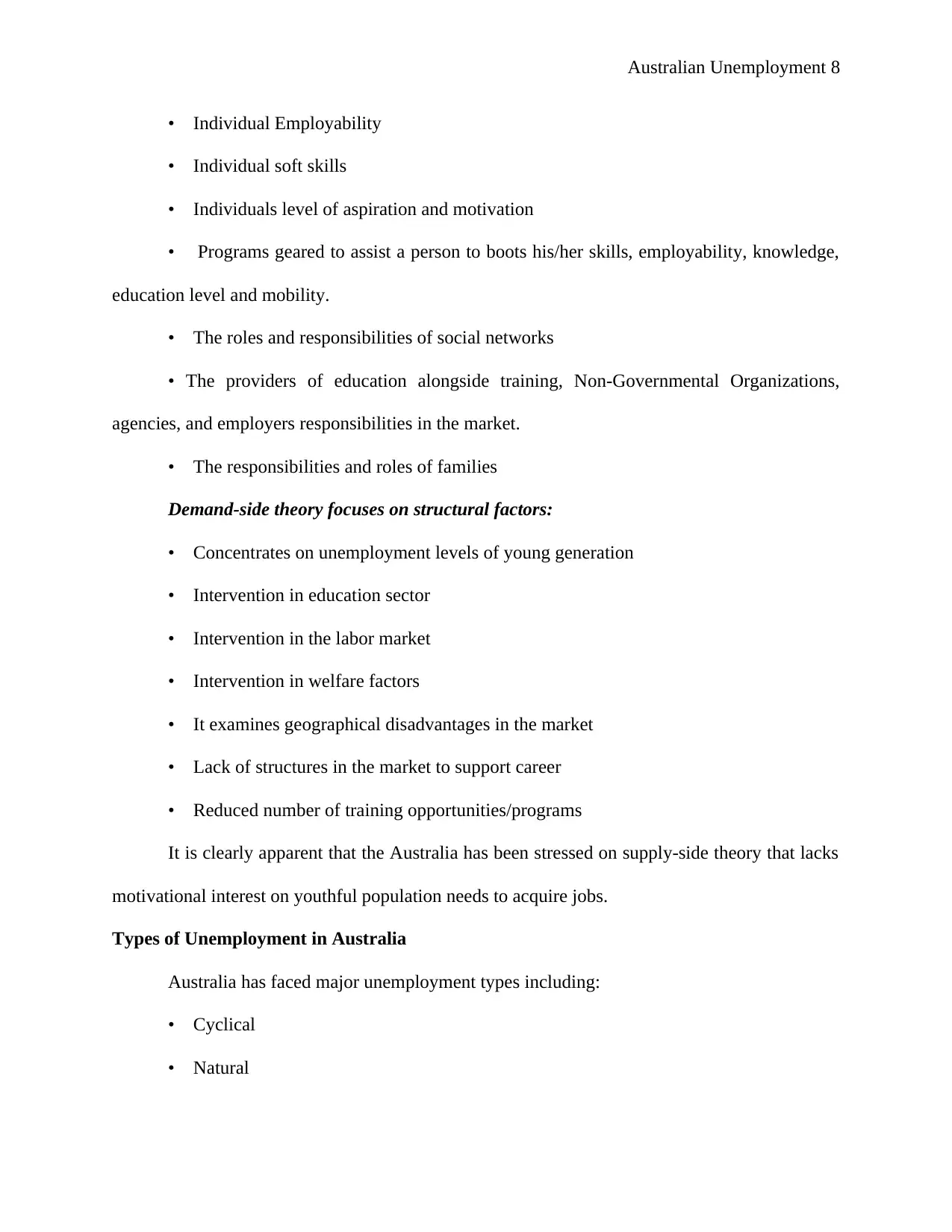
Australian Unemployment 8
• Individual Employability
• Individual soft skills
• Individuals level of aspiration and motivation
• Programs geared to assist a person to boots his/her skills, employability, knowledge,
education level and mobility.
• The roles and responsibilities of social networks
• The providers of education alongside training, Non-Governmental Organizations,
agencies, and employers responsibilities in the market.
• The responsibilities and roles of families
Demand-side theory focuses on structural factors:
• Concentrates on unemployment levels of young generation
• Intervention in education sector
• Intervention in the labor market
• Intervention in welfare factors
• It examines geographical disadvantages in the market
• Lack of structures in the market to support career
• Reduced number of training opportunities/programs
It is clearly apparent that the Australia has been stressed on supply-side theory that lacks
motivational interest on youthful population needs to acquire jobs.
Types of Unemployment in Australia
Australia has faced major unemployment types including:
• Cyclical
• Natural
• Individual Employability
• Individual soft skills
• Individuals level of aspiration and motivation
• Programs geared to assist a person to boots his/her skills, employability, knowledge,
education level and mobility.
• The roles and responsibilities of social networks
• The providers of education alongside training, Non-Governmental Organizations,
agencies, and employers responsibilities in the market.
• The responsibilities and roles of families
Demand-side theory focuses on structural factors:
• Concentrates on unemployment levels of young generation
• Intervention in education sector
• Intervention in the labor market
• Intervention in welfare factors
• It examines geographical disadvantages in the market
• Lack of structures in the market to support career
• Reduced number of training opportunities/programs
It is clearly apparent that the Australia has been stressed on supply-side theory that lacks
motivational interest on youthful population needs to acquire jobs.
Types of Unemployment in Australia
Australia has faced major unemployment types including:
• Cyclical
• Natural
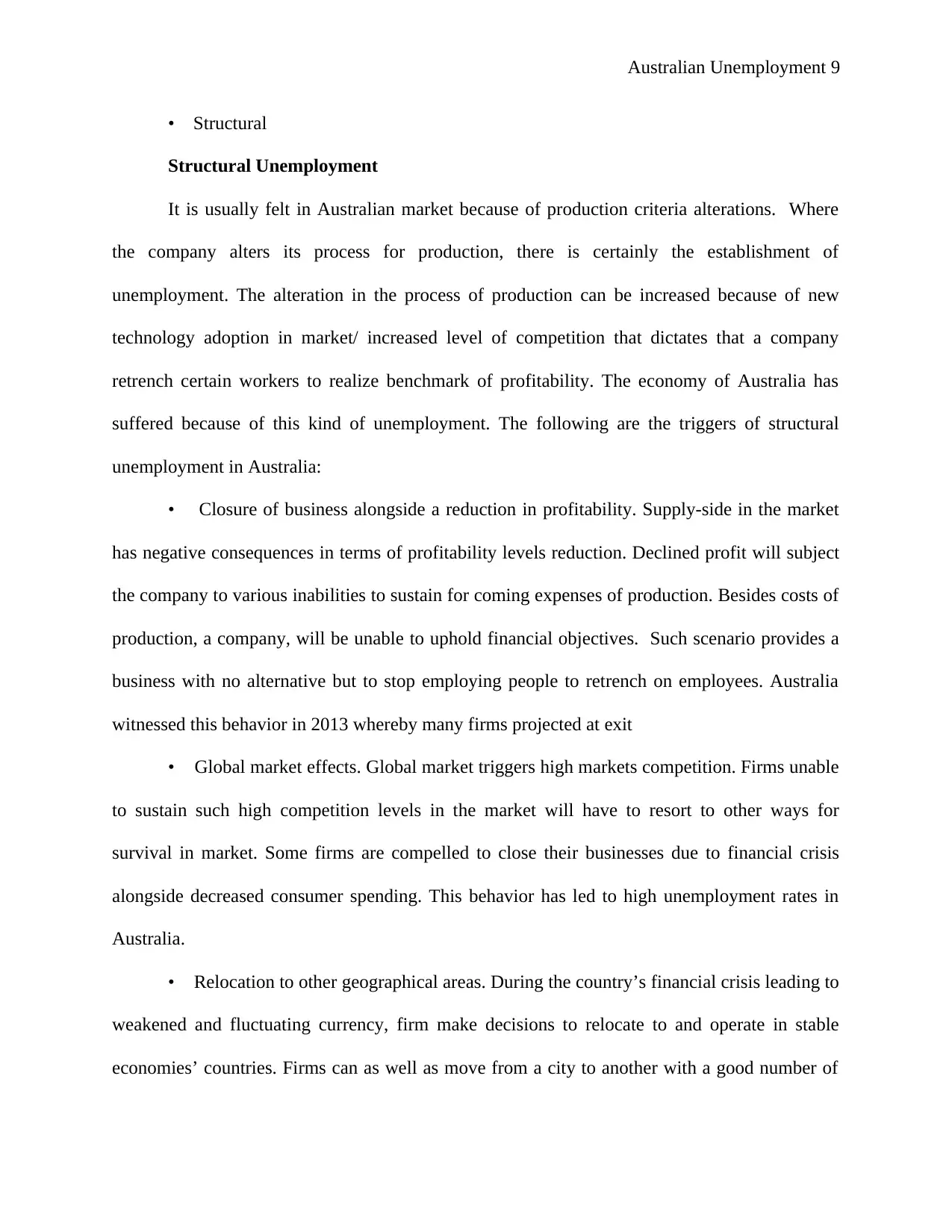
Australian Unemployment 9
• Structural
Structural Unemployment
It is usually felt in Australian market because of production criteria alterations. Where
the company alters its process for production, there is certainly the establishment of
unemployment. The alteration in the process of production can be increased because of new
technology adoption in market/ increased level of competition that dictates that a company
retrench certain workers to realize benchmark of profitability. The economy of Australia has
suffered because of this kind of unemployment. The following are the triggers of structural
unemployment in Australia:
• Closure of business alongside a reduction in profitability. Supply-side in the market
has negative consequences in terms of profitability levels reduction. Declined profit will subject
the company to various inabilities to sustain for coming expenses of production. Besides costs of
production, a company, will be unable to uphold financial objectives. Such scenario provides a
business with no alternative but to stop employing people to retrench on employees. Australia
witnessed this behavior in 2013 whereby many firms projected at exit
• Global market effects. Global market triggers high markets competition. Firms unable
to sustain such high competition levels in the market will have to resort to other ways for
survival in market. Some firms are compelled to close their businesses due to financial crisis
alongside decreased consumer spending. This behavior has led to high unemployment rates in
Australia.
• Relocation to other geographical areas. During the country’s financial crisis leading to
weakened and fluctuating currency, firm make decisions to relocate to and operate in stable
economies’ countries. Firms can as well as move from a city to another with a good number of
• Structural
Structural Unemployment
It is usually felt in Australian market because of production criteria alterations. Where
the company alters its process for production, there is certainly the establishment of
unemployment. The alteration in the process of production can be increased because of new
technology adoption in market/ increased level of competition that dictates that a company
retrench certain workers to realize benchmark of profitability. The economy of Australia has
suffered because of this kind of unemployment. The following are the triggers of structural
unemployment in Australia:
• Closure of business alongside a reduction in profitability. Supply-side in the market
has negative consequences in terms of profitability levels reduction. Declined profit will subject
the company to various inabilities to sustain for coming expenses of production. Besides costs of
production, a company, will be unable to uphold financial objectives. Such scenario provides a
business with no alternative but to stop employing people to retrench on employees. Australia
witnessed this behavior in 2013 whereby many firms projected at exit
• Global market effects. Global market triggers high markets competition. Firms unable
to sustain such high competition levels in the market will have to resort to other ways for
survival in market. Some firms are compelled to close their businesses due to financial crisis
alongside decreased consumer spending. This behavior has led to high unemployment rates in
Australia.
• Relocation to other geographical areas. During the country’s financial crisis leading to
weakened and fluctuating currency, firm make decisions to relocate to and operate in stable
economies’ countries. Firms can as well as move from a city to another with a good number of
⊘ This is a preview!⊘
Do you want full access?
Subscribe today to unlock all pages.

Trusted by 1+ million students worldwide
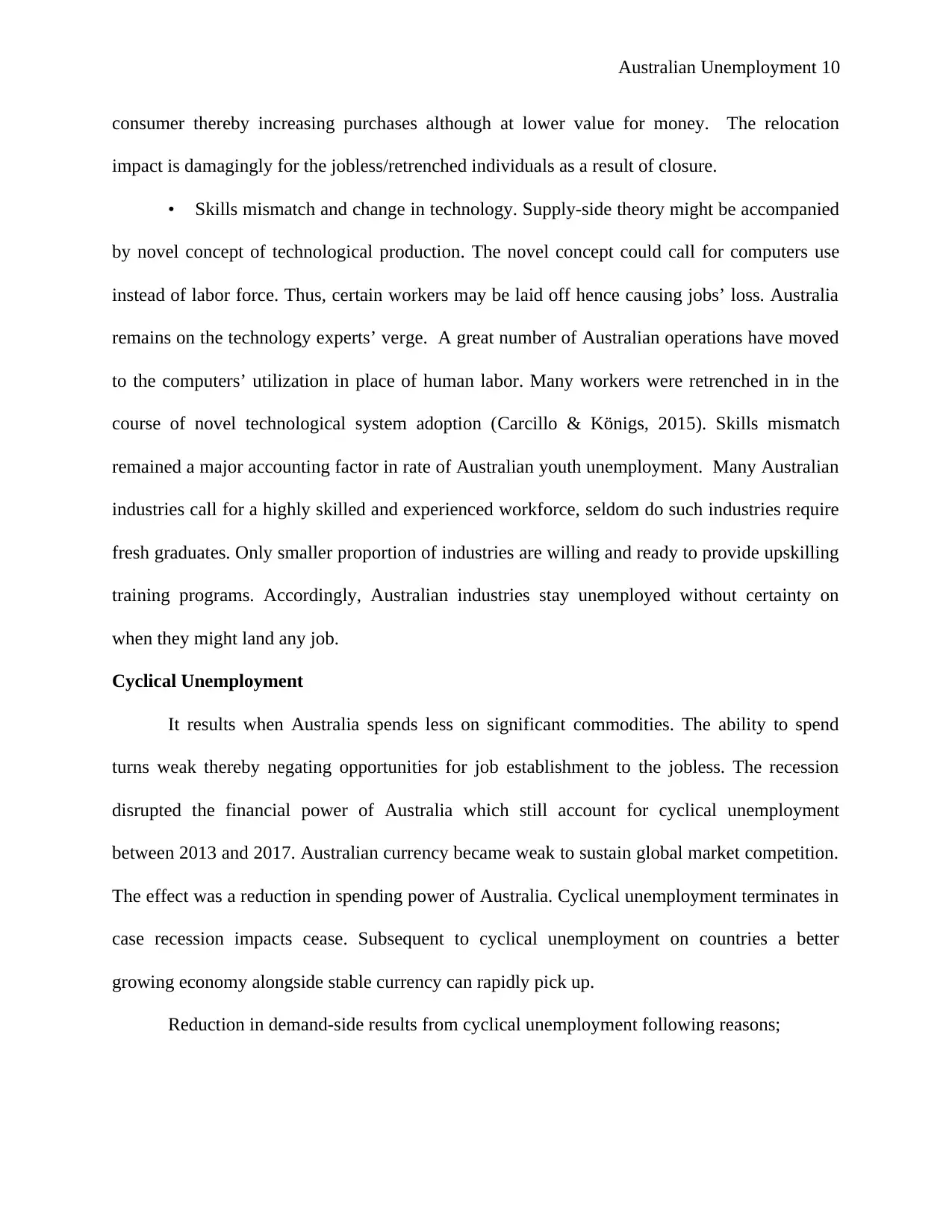
Australian Unemployment 10
consumer thereby increasing purchases although at lower value for money. The relocation
impact is damagingly for the jobless/retrenched individuals as a result of closure.
• Skills mismatch and change in technology. Supply-side theory might be accompanied
by novel concept of technological production. The novel concept could call for computers use
instead of labor force. Thus, certain workers may be laid off hence causing jobs’ loss. Australia
remains on the technology experts’ verge. A great number of Australian operations have moved
to the computers’ utilization in place of human labor. Many workers were retrenched in in the
course of novel technological system adoption (Carcillo & Königs, 2015). Skills mismatch
remained a major accounting factor in rate of Australian youth unemployment. Many Australian
industries call for a highly skilled and experienced workforce, seldom do such industries require
fresh graduates. Only smaller proportion of industries are willing and ready to provide upskilling
training programs. Accordingly, Australian industries stay unemployed without certainty on
when they might land any job.
Cyclical Unemployment
It results when Australia spends less on significant commodities. The ability to spend
turns weak thereby negating opportunities for job establishment to the jobless. The recession
disrupted the financial power of Australia which still account for cyclical unemployment
between 2013 and 2017. Australian currency became weak to sustain global market competition.
The effect was a reduction in spending power of Australia. Cyclical unemployment terminates in
case recession impacts cease. Subsequent to cyclical unemployment on countries a better
growing economy alongside stable currency can rapidly pick up.
Reduction in demand-side results from cyclical unemployment following reasons;
consumer thereby increasing purchases although at lower value for money. The relocation
impact is damagingly for the jobless/retrenched individuals as a result of closure.
• Skills mismatch and change in technology. Supply-side theory might be accompanied
by novel concept of technological production. The novel concept could call for computers use
instead of labor force. Thus, certain workers may be laid off hence causing jobs’ loss. Australia
remains on the technology experts’ verge. A great number of Australian operations have moved
to the computers’ utilization in place of human labor. Many workers were retrenched in in the
course of novel technological system adoption (Carcillo & Königs, 2015). Skills mismatch
remained a major accounting factor in rate of Australian youth unemployment. Many Australian
industries call for a highly skilled and experienced workforce, seldom do such industries require
fresh graduates. Only smaller proportion of industries are willing and ready to provide upskilling
training programs. Accordingly, Australian industries stay unemployed without certainty on
when they might land any job.
Cyclical Unemployment
It results when Australia spends less on significant commodities. The ability to spend
turns weak thereby negating opportunities for job establishment to the jobless. The recession
disrupted the financial power of Australia which still account for cyclical unemployment
between 2013 and 2017. Australian currency became weak to sustain global market competition.
The effect was a reduction in spending power of Australia. Cyclical unemployment terminates in
case recession impacts cease. Subsequent to cyclical unemployment on countries a better
growing economy alongside stable currency can rapidly pick up.
Reduction in demand-side results from cyclical unemployment following reasons;
Paraphrase This Document
Need a fresh take? Get an instant paraphrase of this document with our AI Paraphraser

Australian Unemployment 11
• Decreased firm’s confidence level. A decrease in firm’s confidence level as a result of
instability of economy results in plant’s closure. Firms cease the production because of absence
of market demand. Firm will thus make no sales. The close down culminate in unemployment in
Australia.
• The declined level of income of household. Where household income level drops,
spending habit among household hampers emptying into a demand decline. When Australian
demand level goes downwards, firms shall not produce hence employed workers will be jobless.
• Pessimistic nature of Consumers. Where consumers anticipate uncertain future
employment conditions, they halt expenditure forcing several closures among firms.
Natural Unemployment
It is mainly a supply-side-derived unemployment. It is usually widespread in Australia
irrespective of stability of the economy. It is also widespread in healthy economies. It results
from supply-side impact on market thereby altering the manner of firms’ operations. It hampers
original production processes organization, profitability of business as well as recruitment
system (Bell & Blanchflower, 2015).
Unemployment by States in Australia
Australia’s unemployment differs across states because of diverse state’s economic
power. States mentioned here include Tasmania, New South Wales, Western Australia, and
Queensland alongside South Australia. The unemployment rate varies without any state equals to
another.
Tasmania currently shows the highest rate of unemployment among these states.
Tasmania’s rate or unemployment stood at 22.2 percent overall with youth unemployment rate
being 10.1 percent. This demonstrates degree of agony triggered arose from GFC. A great
• Decreased firm’s confidence level. A decrease in firm’s confidence level as a result of
instability of economy results in plant’s closure. Firms cease the production because of absence
of market demand. Firm will thus make no sales. The close down culminate in unemployment in
Australia.
• The declined level of income of household. Where household income level drops,
spending habit among household hampers emptying into a demand decline. When Australian
demand level goes downwards, firms shall not produce hence employed workers will be jobless.
• Pessimistic nature of Consumers. Where consumers anticipate uncertain future
employment conditions, they halt expenditure forcing several closures among firms.
Natural Unemployment
It is mainly a supply-side-derived unemployment. It is usually widespread in Australia
irrespective of stability of the economy. It is also widespread in healthy economies. It results
from supply-side impact on market thereby altering the manner of firms’ operations. It hampers
original production processes organization, profitability of business as well as recruitment
system (Bell & Blanchflower, 2015).
Unemployment by States in Australia
Australia’s unemployment differs across states because of diverse state’s economic
power. States mentioned here include Tasmania, New South Wales, Western Australia, and
Queensland alongside South Australia. The unemployment rate varies without any state equals to
another.
Tasmania currently shows the highest rate of unemployment among these states.
Tasmania’s rate or unemployment stood at 22.2 percent overall with youth unemployment rate
being 10.1 percent. This demonstrates degree of agony triggered arose from GFC. A great
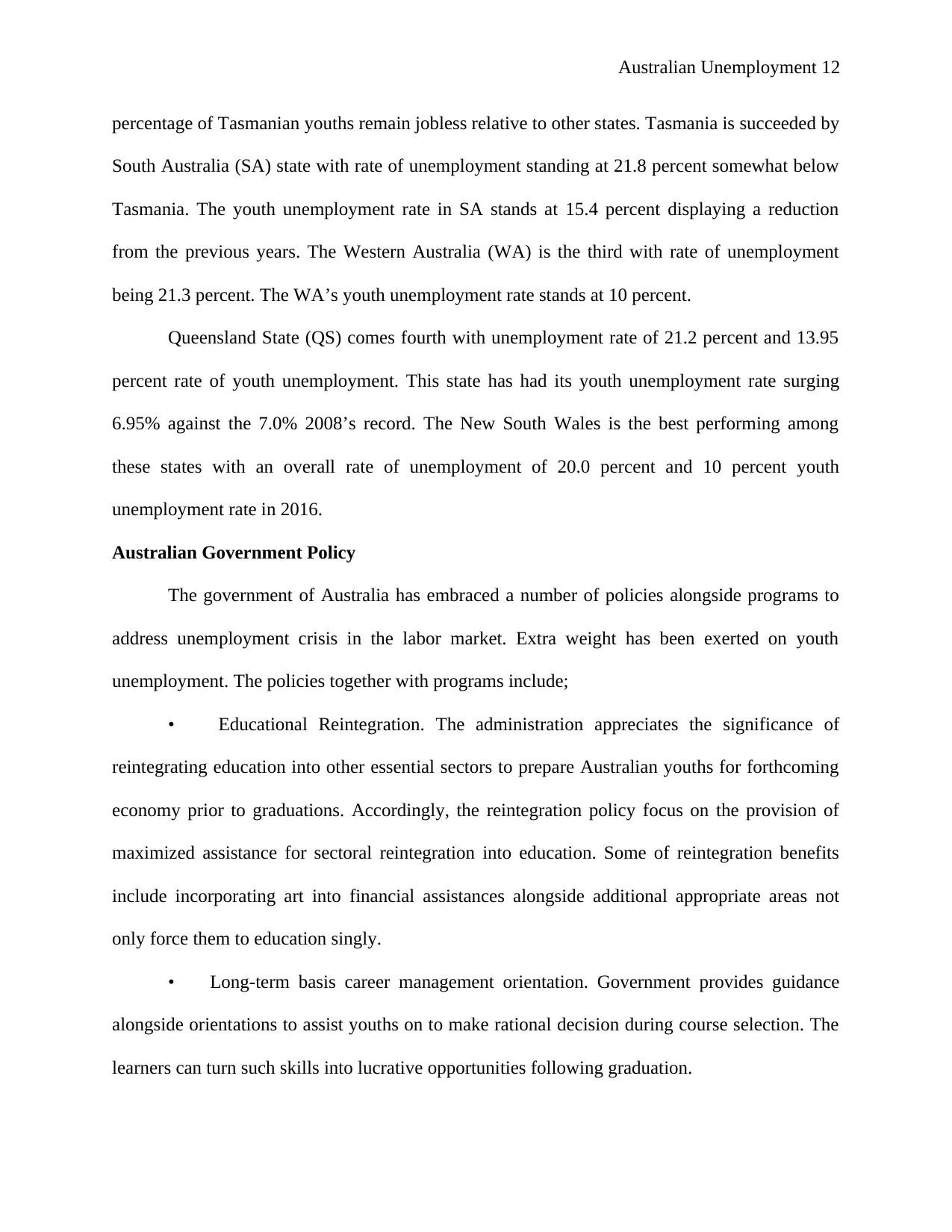
Australian Unemployment 12
percentage of Tasmanian youths remain jobless relative to other states. Tasmania is succeeded by
South Australia (SA) state with rate of unemployment standing at 21.8 percent somewhat below
Tasmania. The youth unemployment rate in SA stands at 15.4 percent displaying a reduction
from the previous years. The Western Australia (WA) is the third with rate of unemployment
being 21.3 percent. The WA’s youth unemployment rate stands at 10 percent.
Queensland State (QS) comes fourth with unemployment rate of 21.2 percent and 13.95
percent rate of youth unemployment. This state has had its youth unemployment rate surging
6.95% against the 7.0% 2008’s record. The New South Wales is the best performing among
these states with an overall rate of unemployment of 20.0 percent and 10 percent youth
unemployment rate in 2016.
Australian Government Policy
The government of Australia has embraced a number of policies alongside programs to
address unemployment crisis in the labor market. Extra weight has been exerted on youth
unemployment. The policies together with programs include;
• Educational Reintegration. The administration appreciates the significance of
reintegrating education into other essential sectors to prepare Australian youths for forthcoming
economy prior to graduations. Accordingly, the reintegration policy focus on the provision of
maximized assistance for sectoral reintegration into education. Some of reintegration benefits
include incorporating art into financial assistances alongside additional appropriate areas not
only force them to education singly.
• Long-term basis career management orientation. Government provides guidance
alongside orientations to assist youths on to make rational decision during course selection. The
learners can turn such skills into lucrative opportunities following graduation.
percentage of Tasmanian youths remain jobless relative to other states. Tasmania is succeeded by
South Australia (SA) state with rate of unemployment standing at 21.8 percent somewhat below
Tasmania. The youth unemployment rate in SA stands at 15.4 percent displaying a reduction
from the previous years. The Western Australia (WA) is the third with rate of unemployment
being 21.3 percent. The WA’s youth unemployment rate stands at 10 percent.
Queensland State (QS) comes fourth with unemployment rate of 21.2 percent and 13.95
percent rate of youth unemployment. This state has had its youth unemployment rate surging
6.95% against the 7.0% 2008’s record. The New South Wales is the best performing among
these states with an overall rate of unemployment of 20.0 percent and 10 percent youth
unemployment rate in 2016.
Australian Government Policy
The government of Australia has embraced a number of policies alongside programs to
address unemployment crisis in the labor market. Extra weight has been exerted on youth
unemployment. The policies together with programs include;
• Educational Reintegration. The administration appreciates the significance of
reintegrating education into other essential sectors to prepare Australian youths for forthcoming
economy prior to graduations. Accordingly, the reintegration policy focus on the provision of
maximized assistance for sectoral reintegration into education. Some of reintegration benefits
include incorporating art into financial assistances alongside additional appropriate areas not
only force them to education singly.
• Long-term basis career management orientation. Government provides guidance
alongside orientations to assist youths on to make rational decision during course selection. The
learners can turn such skills into lucrative opportunities following graduation.
⊘ This is a preview!⊘
Do you want full access?
Subscribe today to unlock all pages.

Trusted by 1+ million students worldwide
1 out of 15
Related Documents
Your All-in-One AI-Powered Toolkit for Academic Success.
+13062052269
info@desklib.com
Available 24*7 on WhatsApp / Email
![[object Object]](/_next/static/media/star-bottom.7253800d.svg)
Unlock your academic potential
Copyright © 2020–2025 A2Z Services. All Rights Reserved. Developed and managed by ZUCOL.





